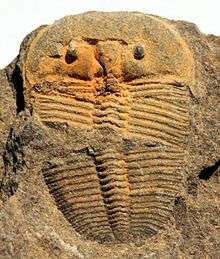Aulacopleura
| Aulacopleura Temporal range: 472–385 Ma | |
|---|---|
 | |
| Aulacopleura konincki, Kosovu Beruna, Czech Republic | |
| Scientific classification | |
| Kingdom: | Animalia |
| Phylum: | Arthropoda |
| Class: | Trilobita |
| Order: | Proetida |
| Family: | Aulacopleuridae |
| Genus: | Aulacopleura Hawle & Corda, 1847 |
| Type species | |
| Arethusa konincki Barrande, 1846 | |
| Species | |
| |
| Synonyms | |
|
Arethusa Barrande, 1846 non De Montfort, 1808, Arethusina Barrande, 1852 | |
Aulacopleura is a genus of proetid trilobite that lived from the Middle Ordovician to the Middle Devonian. The cephalon is semicircular or semielliptical, with border and preglabellar field. The glabella is short, with or without defined eye ridges connecting it with eyes of variable size. Spines at the rear outer corners of the cephalon (or genal spines) are present, typically reaching back to the 2nd to 4th thorax segment. The 'palate' (or hypostome) is not connected to the dorsal shield of the cephalon (or natant). The cephalon is pitted, or has small tubercles. The thorax has up to 22 segments. The pleural ends are usually rounded. The pygidium is small (micropygous), with an even margin.
Taxonomy
Barrande described Arethusa konincki in 1846. However, Arethusa was occupied since it was used by De Montfort in 1808 for a foram protist.[1] Barrande tried to correct this by proposing Arethusina as a replacement, but by that time that Hawle and Corda had already suggested Aulacopleura in 1847, which is thus the senior available name.[2]
Distribution
- A. konincki is known from the Middle Silurian of the Czech Republic (Wenlockian, Liten Formation, Bohemia).
- A. letmathensis has been found in the Middle Devonian of Germany (Givetian).
- A. pogsoni was collected from Lower Silurian of Australia (late Llandovery, upper Cotton Formation, near Forbes, New South Wales).
- A. wulongensis occurs in the Lower Silurian of China (Llandovery, Sichuan).[3]
References
- ↑ Micropaleontology Press. "ARETHUSA Denys de Montfort, 1808" (PDF).
- ↑ Moore, Raymond C., ed. (1959). Treatise on Invertebrate Paleontology [Part O - Arthropoda 1 (Arthropoda- - General Features, Proarthropoda, Euarthropoda - General Features, Trilobitomorpha)]. Geological Society of America and University of Kansas Press.
- ↑ Edgecombe, G.D.; Sherwin, L. (2001). "Early Silurian (Llandovery) trilobites from the Cotton Formation, near Forbes, New South Wales, Australia". Alcheringa: An Australasian Journal of Palaeontology. 25 (1): 87–105). doi:10.1080/03115510108619215.